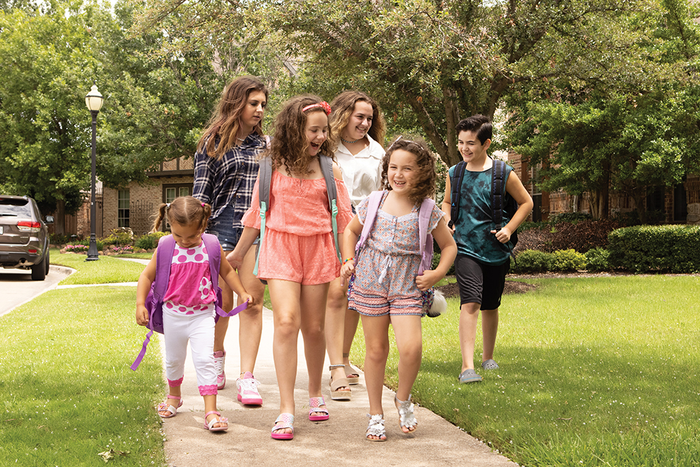The first day of school on August 12 will undoubtedly be filled with excitement – tempered by some nervousness – for the Sevak family of Frisco. </p
p>That is because all six siblings, who range in age from 4 to 15, will report to their respective school campuses for the first time since March 2020, when classroom instruction halted and learning moved online in the wake of the COVID-19 pandemic. </p
p>While the majority of Frisco ISD students returned to in-person instruction at local campuses late last summer, the Sevak children remained at home during the 2020-2021 school year and attended classes through the district’s Virtual School program. </p
p>“I was extremely nervous about sending them back. I had no idea how the school year was going to play out,” mother Lauren Sevak, a Type 1 diabetic who also has rheumatoid arthritis, explained of the family’s decision to continue virtual learning last academic year. Given her health conditions, she said sending the children to campus – where they potentially could have been exposed to the virus – was a risk she and her husband, Chris Sevak, weren’t willing to take. </p
p>Frisco ISD announced in June that it would be unable to move forward with plans for a virtual learning option for students during the 2021-2022 school year after the Texas Legislature’s regular session ended without final approval of a bill that would have expanded online learning and provided funding for full-time virtual students throughout the state. </p
p>That means the Sevak children – as well as others throughout Texas – must return to in-person instruction this month. </p
p>Mr. and Mrs. Sevak and the couple’s two eldest children have received the COVID-19 vaccine. Still, the entire family remains a bit anxious about the “socialization aspect” of heading back to school. “These kids have basically been quarantined” for more than a year, she said, “and we’ve been stressed” for months about the prospect of going back to campus full time. “There’s anxiety on every level.” </p
p>There may be a lot of that going around this school year according to Sapna Rad, a Frisco-based certified conscious parenting coach and neuro-linguistic programming practitioner who works mostly with adults. </p
p>Ms. Rad describes conscious parenting as “a powerful and rare blend of Western psychology and Eastern wisdom” that “lends itself to deep healing and awakening.” It “gives insight into the parents’ inner landscape” so that they may “heal their traumas and wounds so that they can then be available to their children and help them manifest the most authentic and expansive versions of themselves.” </p
div class="image-main image-align-center">
She said back-to-school time is always stressful for families but may prove to be more even more so this year. “I don’t know of one family who is not feeling stressed or anxious about this,” she said. Even if parents “pushed past” their anxiety last fall and returned their children to campus, back-to-school stress coupled with COVID-19 concerns will most certainly “come up again this year.” </p
p>As the start of classes draws near, “It is going to bring up a lot of stress and anxiety, and I would say to expect it,” she said. “Any change, for that matter, is going to (cause) anxiety, especially for kids who have been home for so long in small spaces, in their own small world. … If you expect stress, expect anxiety to surface, you’ll be better equipped” to deal with it.</p
p>When it comes to children and parents approaching the uncertainties of the new school year, Ms. Rad said, “It’s important to understand that we’re all in this together. … Everybody is going to have some level of stress around this, so it’s important to talk about.” </p
p>Children and teens “have to know that their friends are also going to go through what they’re going through. It’s not that they’re alone,” she said. In fact, it may be beneficial for parents to turn the “focus on being back with their friends” so that kids are reminded “how it was before COVID started, how they were connected with their friends, how they used to play with their friends and how much they enjoyed hanging out with their friends.” </p
p>Recognizing the stress that may exist is crucial. Ms. Rad said it can be especially effective for younger children to give a name to the emotional or physical tension they feel. “Call it out, use the word … so that they know it’s part of them. You don’t have to reject it, you don’t have to avoid it, but you have the tools now to manage it.” </p
p>Meanwhile, it is important for teens to be “authentic, real about what’s happening in their mind, (to express) this is how their body feels. That’s the goal so they’re not alone with” their stress, she said. </p
p>Kids of all ages should feel safe speaking to parents, teachers, a school counselor, sports coach and even their peers about their thoughts and emotions surrounding the return to in-person learning. Talking about stress “will normalize it,” she said, and “loosen the hold that it has on you so you (do not) feel like you’re alone in this. That’s where the healing starts.” </p
p>At the same time, parents should also keep tabs on any changes in their children’s behaviors, Ms. Rad said. “Are they doing anything out of the ordinary? Are they engaging in any kind of behavior” that is unusual for them? In the case of young kids, that may be kicking or hitting others, while older children and teens may withdraw and become shyer than they were previously. </p
p>As the school year ramps up, Ms. Rad suggests families “take baby steps” when establishing new routines or returning to old ones. While it is important to “have a schedule to create normalcy so the kids know what to expect,” being less rigid about how it is maintained may be beneficial for all family members. </p
p>For example, if kids aren’t ready to eat dinner by 6:30 p.m., consider moving mealtime to 7 o’clock. If a child has trouble falling asleep on a school night, parents may extend bedtime by 30 minutes and instead play a game or talk with their children to “create that safety around the anxiety that the child is feeling.” </p
p>In helping children process and cope with their back-to-school stress, it is important l that parents also be cognizant of their own concerns so that they are better “able to understand their kids,” Ms. Rad said. “Parents have to monitor their stress levels, become aware of their anxieties … their fears about what’s going to happen.” </p
p>She advises adults “to take care of themselves … because kids need us, and we need to respond and (be) healthy. It’s a call for us to be our best selves.”






